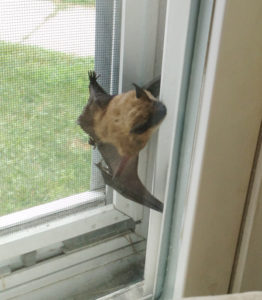By Gordon Woodworth, Chronicle News Editor
Last week’s Chronicle story and photo about Big Brown Bat encounters in the Glens Falls region prompted numerous readers to chime in with more incidents.
The state’s bat expert isn’t surprised.
“This is the time of year when we see a huge spike in encounters because in mid to late August, young bats that are born this year start to leave their mothers, and they make bad decisions as young folks do,” said wildlife biologist Carl Herzog, who oversees the state Department of Environmental Conservation’s bat conservation and management efforts.
“Up until this point they were living in a colony with their mom, who was feeding them every day. Now they are fending for themselves. We always see a huge increase in sightings because of that, a really sharp spike.”
Elyssa Carson, who lives on Center Street in Glens Falls, knows first-hand.

She e-mailed to say, “We too had a bat incident.” She said she and her husband found a bat between the screen and window in their living room on July 29. The bat, very likely a Big Brown Bat, flew off after they lifted the outside screen.
“He definitely wasn’t happy to be in there and hissed a lot at us through the window,” Mrs. Carson said, estimating the bat had at least a 10-inch wingspan.
Jill Mammone of Hudson Falls wrote that “I’ve had seven, yes seven, in my house in the past week! What is going on?!”
She said she’s had one bat every night for a week, adding “we’ve set them all free.”
Asked how big they were, she said, “I wasn’t measuring while I was screaming…sorry! Eeek! I can’t even narrow it down to one place in my house. They’ve been upstairs and downstairs and yes, I do have a fireplace.”
Asked if we could publish her name, she said, “Okay, I have nothing to hide. I have a serious bat problem.”
Carol Bosley of Madison Street in Glens Falls wrote that she and her husband were watching television on Aug. 8 when a bat flew in front of them, then upstairs into their bedroom. She said her husband captured and killed it and put it in the trash
.
Mr. Herzog said Big Brown Bats “are the most common species that people encounter because they live in buildings.”
He said their population has been “super steady,” mainly because they are not nearly as affected by the fatal White Nose Syndrome that has killed off 90% of the Little Brown Bats in New York.
“The Little Brown Bat population has stabilized at about 10% of what it once was,” he said. “We are hoping to see a recovery eventually, but haven’t seen it yet.
“Big Brown Bats often have two babies, while Little Brown Bats only have one, so if there is a recovery, it will take a long time.”
He said the state Department of Health follows federal guidelines from the Centers for Disease Control and Prevention (CDC) regarding contact with bats.
Advice if you encounter a bat
“If there is a bat in a room where people are sleeping, assume that person or persons were bitten, even if they don’t think they were,” Mr. Herzog said. “If you catch the bat, submit it for rabies testing and contact your county health department.
“If you can, get it out of the house and let it go. Put a box over it and slide a piece of cardboard underneath, or using a fishing net. You want to prevent skin-to-skin contact. Even leather gloves are okay, if you can get your hands on a bat.
“But you want to avoid skin-to-skin contact. The point at which rabies shots are highly recommended is if you have skin-to-skin contact with a bat, not if you’re bitten. It’s a highly cautious approach.”
Copyright © 2016 Lone Oak Publishing Co., Inc. All Rights Reserved.
 Glens Falls Chronicle Serving the Glens Falls/Lake George region; Warren, Washington and northern Saratoga counties since 1980
Glens Falls Chronicle Serving the Glens Falls/Lake George region; Warren, Washington and northern Saratoga counties since 1980

